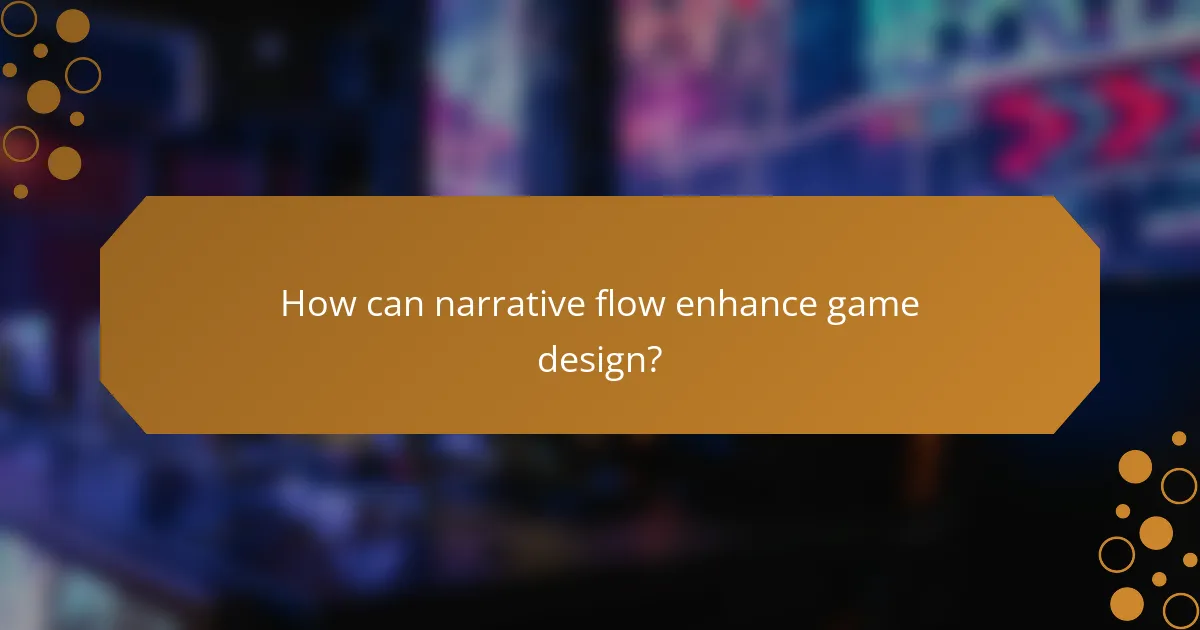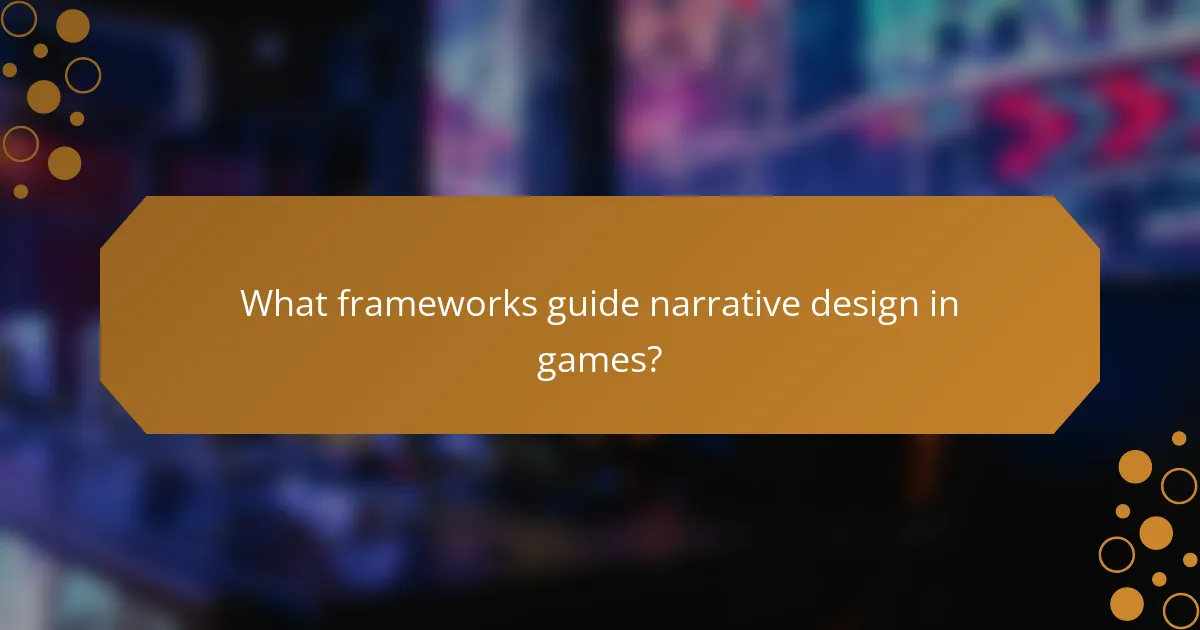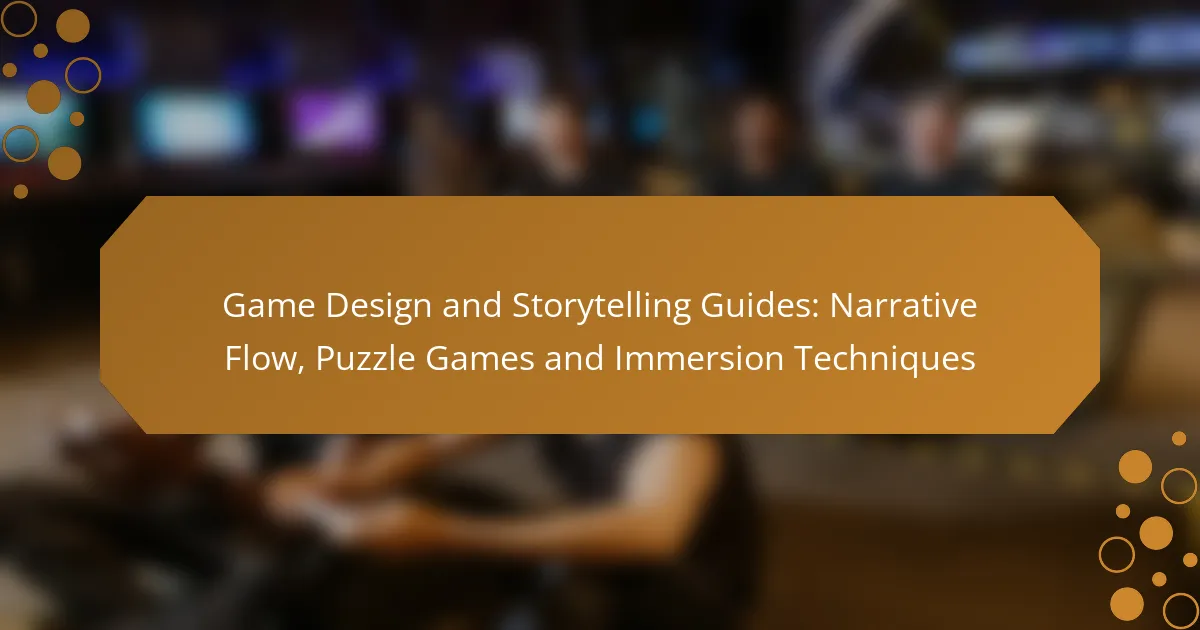In game design, narrative flow is essential for keeping players engaged and immersed in the story. By structuring narratives effectively, designers can forge emotional connections and provide context for player actions. Additionally, puzzle game mechanics challenge players’ problem-solving skills, while immersion techniques enhance the overall experience, making players feel like active participants in the game world.

How can narrative flow enhance game design?
Narrative flow is crucial in game design as it guides players through the story, maintaining engagement and immersion. A well-structured narrative can enhance gameplay by creating emotional connections and providing context for player actions.
Engaging character arcs
Character arcs are essential for developing relatable and memorable protagonists and antagonists. Players are more likely to invest in characters who undergo significant growth or change, which can drive the narrative forward. For instance, a hero who starts as timid but evolves into a courageous leader can resonate deeply with players.
To create engaging character arcs, consider the character’s motivations, conflicts, and resolutions. Ensure that their journey is clear and impactful, allowing players to witness their transformation throughout the game.
Dynamic plot progression
Dynamic plot progression keeps the story fresh and responsive to player actions. By incorporating branching narratives or multiple endings, players feel a sense of agency that can enhance their overall experience. For example, choices made early in the game can lead to vastly different outcomes later on.
To implement dynamic plot progression, outline key decision points that will alter the course of the story. This approach not only increases replayability but also encourages players to explore different narrative paths.
Player choice impact
Player choices significantly impact narrative flow, shaping the story based on individual decisions. This engagement can lead to a more personalized experience, making players feel their choices matter. Games like “The Witcher” series exemplify how player decisions can influence character relationships and plot outcomes.
When designing player choices, ensure they are meaningful and have clear consequences. Avoid choices that feel superficial or do not affect the overall narrative, as this can lead to player frustration and disengagement.
Emotional resonance techniques
Emotional resonance techniques help create a deeper connection between players and the narrative. Techniques such as music, visual storytelling, and character backstories can evoke feelings that enhance the gaming experience. For instance, a poignant musical score during a pivotal moment can amplify the emotional weight of a scene.
To effectively use emotional resonance, consider the pacing of your narrative and how different elements can be combined to elicit specific feelings. Utilize feedback from playtesting to gauge emotional responses and adjust elements accordingly for maximum impact.

What are effective puzzle game mechanics?
Effective puzzle game mechanics engage players by challenging their problem-solving skills while providing a sense of accomplishment. These mechanics often include a variety of challenges that require logical reasoning, environmental interaction, and time management.
Logic-based challenges
Logic-based challenges require players to use reasoning and deduction to solve problems. These puzzles often present scenarios where players must analyze clues, patterns, or sequences to arrive at a solution. For example, a common logic puzzle might involve arranging colored blocks in a specific order based on given hints.
When designing these challenges, ensure that the clues are clear but not overly obvious. A good balance keeps players engaged without leading to frustration. Consider using a tiered difficulty system, where initial puzzles are simpler and gradually increase in complexity.
Environmental puzzles
Environmental puzzles leverage the game world itself as a tool for problem-solving. Players must interact with their surroundings, manipulating objects or navigating spaces to progress. For instance, a player might need to find a hidden key by moving furniture or activating mechanisms within a room.
To create engaging environmental puzzles, think about how players can use their surroundings creatively. Incorporate elements that encourage exploration and experimentation, such as hidden pathways or interactive objects. This can enhance immersion and make the gameplay experience more rewarding.
Timed challenges
Timed challenges add urgency to puzzle-solving, requiring players to complete tasks within a set time limit. These mechanics can heighten tension and excitement, making players feel more invested in their success. An example could be defusing a bomb where players must solve a series of puzzles before time runs out.
When implementing timed challenges, consider the balance between difficulty and time constraints. Too little time can lead to frustration, while too much can diminish the sense of urgency. A good rule of thumb is to allow players enough time to think through their options while still feeling the pressure to act quickly.

How do immersion techniques improve player experience?
Immersion techniques enhance player experience by creating a more engaging and believable game world. These methods draw players into the narrative and gameplay, making them feel like active participants rather than passive observers.
Audio-visual synchronization
Audio-visual synchronization involves aligning sound effects, music, and visuals to create a cohesive experience. When players hear a sound that matches an on-screen action, such as a door creaking open, it reinforces the game’s reality and heightens emotional responses.
To effectively implement this, consider using sound cues that correspond to specific actions or events. For example, a dramatic score can elevate tension during a chase scene. Ensure that audio cues are not only synchronized but also varied to maintain player engagement.
Interactive storytelling
Interactive storytelling allows players to influence the narrative through their choices, creating a personalized experience. This technique can lead to multiple story paths and endings, encouraging players to explore different outcomes and enhancing replayability.
When designing interactive narratives, provide meaningful choices that impact the story significantly. Avoid superficial options that do not alter the game’s progression. Incorporating character development and branching dialogues can deepen player investment in the story.
Virtual reality integration
Virtual reality (VR) integration immerses players in a 360-degree environment, making them feel physically present in the game world. This technique can enhance emotional connections and provide unique gameplay experiences that traditional formats cannot offer.
To effectively use VR, ensure that the controls are intuitive and that the environment is richly detailed. Consider the physical space available to players, as well as comfort levels to prevent motion sickness. Testing with a variety of users can help refine the experience for broader audiences.

What frameworks guide narrative design in games?
Narrative design in games is often guided by established frameworks that help structure storytelling effectively. These frameworks provide a foundation for creating engaging plots and character arcs that resonate with players.
Three-act structure
The three-act structure is a classic storytelling framework that divides a narrative into three distinct parts: setup, confrontation, and resolution. This model helps maintain pacing and ensures that the story unfolds in a coherent manner, making it easier for players to follow the plot.
In the setup, characters and settings are introduced, establishing the stakes. The confrontation escalates the conflict, often presenting challenges that the protagonist must overcome. Finally, the resolution ties up loose ends, providing closure to the narrative. This structure is widely applicable across various genres, from role-playing games to adventure titles.
When implementing the three-act structure, consider the emotional journey of the player. Ensure that each act builds upon the last, with clear motivations and stakes that evolve throughout the game. Avoid abrupt transitions between acts to maintain immersion.
Hero’s journey model
The hero’s journey model outlines a common narrative arc where a protagonist embarks on an adventure, faces challenges, and ultimately returns transformed. This model resonates with players due to its universal themes of growth and discovery.
The journey typically includes stages such as the call to adventure, crossing the threshold, facing trials, and achieving a return with newfound wisdom. Each stage can be adapted to fit the game’s mechanics and player choices, allowing for a personalized experience.
To effectively use the hero’s journey, focus on character development and player agency. Ensure that the challenges faced by the hero are meaningful and tied to their growth. Avoid clichés by adding unique twists to familiar stages, keeping the narrative fresh and engaging for players.

How can game designers leverage player feedback?
Game designers can effectively leverage player feedback by integrating it into their development process to enhance gameplay and storytelling. This approach not only improves player satisfaction but also fosters a sense of community and ownership among players.
Iterative design processes
Iterative design processes involve continuously refining a game based on player feedback through multiple cycles of testing and development. Designers can implement alpha and beta testing phases to gather insights on gameplay mechanics, story elements, and overall user experience.
For example, a puzzle game might release a demo version to a select group of players, allowing designers to identify which puzzles are too difficult or too easy. This feedback can lead to adjustments that enhance the game’s balance and engagement.
Community engagement strategies
Community engagement strategies focus on building a dialogue with players to gather insights and foster loyalty. Designers can utilize forums, social media, and surveys to solicit feedback and encourage discussions about game features and improvements.
For instance, hosting regular Q&A sessions or feedback polls can help designers understand player preferences and pain points. Additionally, recognizing and incorporating player suggestions can create a more invested community, leading to increased player retention and word-of-mouth promotion.

What are the trends in narrative-driven games?
Narrative-driven games are increasingly focusing on player agency, emotional engagement, and immersive storytelling techniques. Trends include the integration of branching narratives, character-driven plots, and the use of advanced technologies to enhance storytelling experiences.
Emerging technologies in storytelling
Emerging technologies are reshaping how stories are told in games, allowing for more interactive and immersive experiences. Virtual reality (VR) and augmented reality (AR) are at the forefront, enabling players to engage with narratives in ways that were previously impossible. For example, VR can place players directly in the story, making them feel like active participants rather than passive observers.
Another significant trend is the use of artificial intelligence (AI) to create dynamic narratives that adapt to player choices. AI can analyze player behavior and modify storylines in real-time, offering a unique experience for each player. This can lead to more personalized storytelling, where the game evolves based on individual interactions.
Additionally, cloud gaming technology allows for larger, more complex narratives that can be streamed directly to players’ devices. This means developers can create expansive worlds with rich stories without being limited by hardware constraints. As these technologies continue to develop, they will likely further enhance narrative depth and player immersion.



